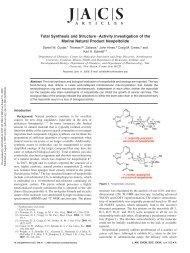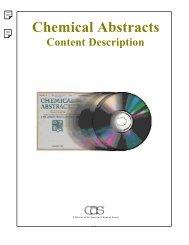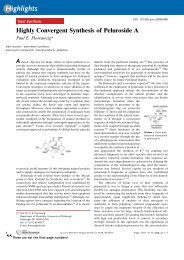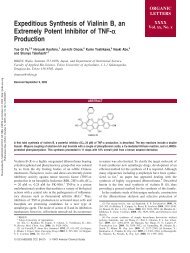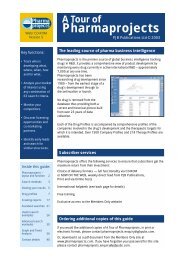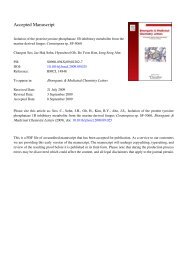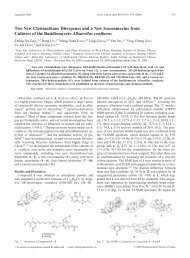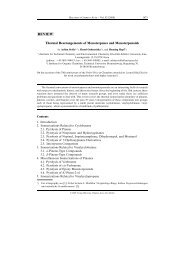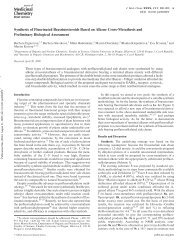Secu'amamines E–G, new alkaloids from Securinega suffruticosa ...
Secu'amamines E–G, new alkaloids from Securinega suffruticosa ...
Secu'amamines E–G, new alkaloids from Securinega suffruticosa ...
Create successful ePaper yourself
Turn your PDF publications into a flip-book with our unique Google optimized e-Paper software.
Secu’amamines <strong>E–G</strong>, <strong>new</strong> <strong>alkaloids</strong> <strong>from</strong> <strong>Securinega</strong> <strong>suffruticosa</strong> var. amamiensis<br />
Ayumi Ohsaki a, *, Takashi Nagaoka a , Kaisuke Yoneda b , Akio Kishida a<br />
a Institute of Biomaterials and Bioengineering, Tokyo Medical and Dental University, Chiyoda-ku, Tokyo 101-0062, Japan<br />
b Graduate School of Pharmaceutical Science, Suita, Osaka 565-0871, Japan<br />
article info<br />
Article history:<br />
Received 28 August 2009<br />
Revised 18 September 2009<br />
Accepted 24 September 2009<br />
Available online xxxx<br />
abstract<br />
In a search for biologically active and structurally unique compounds<br />
in subtropical and tropical medicinal plants, 1 we investigated<br />
the minor constituents of <strong>Securinega</strong> <strong>suffruticosa</strong> (Pall.) var.<br />
amamiensis Hurusawa (Euphorbiaceae), 2 which grows in the Ryukyu<br />
Islands, the subtropical region of Japan. Its main alkaloid,<br />
securinine, 3 has been reported to be a GABA A receptor antagonist<br />
with significant in vivo CNS activity. 4 Securinine also has been reported<br />
to exhibit antimalarial 5 activity and antibacterial 6 activity,<br />
as well as apoptotic activity in human leukemia HL-60 cells. 7 Previously,<br />
we reported the structure of secu’amamines A–D. 8,9 Secu’amamine<br />
A has a novel structural framework, which was<br />
investigated in order to achieve total synthesis. 10<br />
In this Letter, we describe the isolation and elucidation of the<br />
structure of a <strong>new</strong> ent-neosecurinane alkaloid, 11 secu’amamine E<br />
(1), and novel <strong>alkaloids</strong>, secu’amamines F (2) and G (3), consisting<br />
of a ent-neosecurinane and a piperidine unit.<br />
The leaves and twigs of S. <strong>suffruticosa</strong> var. amaminensis (dry<br />
weight, 366 g) were extracted with MeOH. The MeOH extracts<br />
(57.0 g) were partitioned between petroleum ether, EtOAc and 3%<br />
aqueous tartaric acid. Water-soluble materials were adjusted to<br />
pH 10 with Na2CO3 and successively partitioned with CHCl3, EtOAc,<br />
and n-BuOH.<br />
The alkaloidal CHCl3-soluble materials (1.18 g) were subjected<br />
to amino-silica gel column chromatography (hexane/EtOAc,<br />
100:0?0:100, and then EtOAc/MeOH, 100:0?20:80, Chromatorex-NH,<br />
Fuji Silysia, Japan) to obtain eight fractions (F1-8). The fifth<br />
fraction (F-5, hexane/EtOAc, 1:1, 35.3 mg) was separated on a silica-gel<br />
column (hexane/EtOAc, 100:0?0:100, and then EtOAc/<br />
MeOH, 100:0?0:100, Wako-gel, C-300, Wako) and purified using<br />
TLC plates (Et2O/CH2Cl2, 1:1, NH2-F254S, Merck) to isolate secu’amamine<br />
E (2.5 mg). The seventh fraction (F-7, hexane/EtOAc, 3:7,<br />
598 mg) was separated by using LH-20 (MeOH, Sephadex), and<br />
then silica gel (CHCl3/MeOH, 100:0?0:100) followed by reversed<br />
0040-4039/$ - see front matter Ó 2009 Elsevier Ltd. All rights reserved.<br />
doi:10.1016/j.tetlet.2009.09.138<br />
ARTICLE IN PRESS<br />
Tetrahedron Letters xxx (2009) xxx–xxx<br />
Contents lists available at ScienceDirect<br />
Tetrahedron Letters<br />
journal homepage: www.elsevier.com/locate/tetlet<br />
One <strong>new</strong> ent-neosecurinane-type alkaloid, secu’amamine E (1), and two novel <strong>alkaloids</strong> consisting of a<br />
ent-neosecurinane and a piperidine unit, secu’amamine F (2), and secu’amamine G (3), were isolated <strong>from</strong><br />
<strong>Securinega</strong> <strong>suffruticosa</strong> var. amamiensis. Their structures and stereochemistry were elucidated on the basis<br />
of spectroscopic analyses.<br />
Ó 2009 Elsevier Ltd. All rights reserved.<br />
phase HPLC (MeOH/30 mM, (NH4)2CO3, 6:4, CAPCEL PAK C18,<br />
Shiseido, Japan) to isolate secu’amamines F (2, 2.0 mg) and G (3,<br />
2.9 mg).<br />
The molecular formula, C13H17NO3, of secu’amamine E (1), {½aŠ 25<br />
D<br />
43.8 (c 0.08, MeOH)} was established by HREIMS [m/z 235.1186,<br />
M + , D 2.2 mmu]. The IR spectrum suggested the presence of a hydroxyl<br />
group (3437 cm 1 ) and an a,b-unsaturated c-lactone group<br />
(1739, 1651 cm 1 ). The gross structure of secur’amamine E (1) was<br />
deduced <strong>from</strong> extensive analyses of the 1 H, 13 C NMR, and DEPT<br />
experiments and 2D NMR data ( 1 H– 1 H COSY, HSQC, HMBC, and<br />
TOCSY). These data for 1 indicated one ester carbonyl, one sp 3<br />
oxy quaternary, one sp 3 oxymethine, one sp 2 methine, one sp 2 quaternary,<br />
two sp 3 methine, and six sp 3 methylene carbons. With two<br />
of six unsaturations thus accounted for, it was concluded that 1<br />
contains four rings (rings A–D). The 1 H– 1 H COSY spectrum revealed<br />
connectivities of C-2 to C-6, C-7 to C-9, and C-7 to C-15<br />
(Fig. 2A). HMBC correlations were observed <strong>from</strong> H-2 to C-4, C-6,<br />
and C-9, <strong>from</strong> H-3 to C-2, C-4, and C-10, <strong>from</strong> H-5 to C-4, and C-<br />
6, <strong>from</strong> H-9 to C-2, C-7, C-8, C-10, and C-14, <strong>from</strong> H-7 to C-2, <strong>from</strong><br />
* Corresponding author. Tel./fax: +81 3 5280 8153.<br />
E-mail address: a-ohsaki.fm@tmd.ac.jp (A. Ohsaki). Figure 1. Chemical structure of compounds 1–6.<br />
Please cite this article in press as: Ohsaki, A.; et al. Tetrahedron Lett. (2009), doi:10.1016/j.tetlet.2009.09.138
Figure 2. Key HMBC correlations of secu’amamine E (1) and the piperidine unit of<br />
secu’amamine F (2) and G (3).<br />
H-8 to C-15, and <strong>from</strong> H-15 to C-7 and C-14. These correlations<br />
indicated the presence of a 1,4-ethano-quinolizine skeleton with<br />
one hydroxy group at C-8 (rings A, B, and C). Further, the cross<br />
peaks of HMBC observed <strong>from</strong> H-15 to C-13 (sp 2 olefinic carbon<br />
of a,b-unsaturated c-lactone), <strong>from</strong> H-13 to C-10, C-12, and C-14<br />
and <strong>from</strong> H-2 to C-10 and C-14 (Fig. 2A). These correlations suggested<br />
that compound 1 has a neosecurinane skeleton. 11 Therefore,<br />
the gross structure of secu’amamine E (1) was elucidated as 1<br />
(Fig. 1).<br />
The NMR data of compound 1 were compared with the NMR<br />
data of securinol A (4), 11 which was <strong>new</strong>ly isolated by us <strong>from</strong> this<br />
plant. Their 13 C NMR data differed at C-2, 8, and 14, and the coupling<br />
pattern of the oxygenated proton H-8 (dH 4.33, dddd) was different<br />
<strong>from</strong> that of 4. These findings indicated that compound 1 has<br />
differing combinations of chiral centers at C-2, C-7, C-8, and C-10.<br />
(Tables 1 and 2) NOESY correlations of H-2/H-4a, H-2/H-6a, H-2/<br />
H-8, H-6b/H-7, and H-2/H-9a suggested that ring A had a chair-like<br />
form, the angular proton (H-2) between rings A and B was in an<br />
a-orientation, and the proton of H-7 was in a b-orientation, and<br />
in addition, a hydroxyl group at C-8 extended to the outside of its<br />
B/C ring cage. The W-coupling (J = 3.0 Hz) was observed between<br />
Table 1<br />
1 H NMR data of secu’amamines E (1) toG(3) 14<br />
No. 1 a<br />
2 a<br />
3 a<br />
dH (mult, J, Hz) dH (mult, J, Hz) dH (mult, J, Hz)<br />
2 2.79, dd, 12.0, 1.8 2.72, dd, 12.0, 1.8 2.71, dd, 12.1, 2.1<br />
3a 1.50, m 1.38, m 1.38, m<br />
3b 0.86, qd, 12.0, 4.0 0.82, qd, 12.0, 3.9 0.80 qd, 12.1, 3.7<br />
4a 1.35, m 1.26, m 1.25, m<br />
4b 1.81, m 1.73, m 1.73, m<br />
5a,b 1.53m, 1.58m 1.42–1.50, m, 2H 1.42–1.50, m, 2H<br />
6a 2.75, td, 11.0, 3.2 2.68, m 2.67, m<br />
6b 2.94m 2.86, m 2.86, m<br />
7 2.88, ddd, 5.7, 1.4, 1.3 2.81, m 2.81, m<br />
8 4.30, dddd 4.21, dddd 4.27, dddd<br />
9.5, 5.0, 3.0, 1.4 9.5, 5.0, 3.0, 1.4 9.5, 5.0, 3.0, 1.4<br />
9a 2.66, dd, 12.2, 9.5 2.58, dd, 12.2, 9.5 2.57, dd, 12.2, 9.5<br />
9b 1.38, dd, 12.2, 5.0 1.29, dd, 12.2, 5.0 1.29, dd, 12.2, 5.0<br />
13 5.74, t, 1.9<br />
15a 2.82, m 2.83–2.96, m, 2H 2.78–2.96, m, 2H<br />
15b 2.97, ddd, 18.4, 1.9, 1.3<br />
1 0 3.49, dd, 11.5, 2.6 3.44, dd, 11.4, 2.5<br />
3 0 a 3.04, br d, 12.4 2.61, m<br />
3 0 b 2.68, m 3.02, br d, 12.3<br />
4 0 a 1.44, m 1.42, m<br />
4 0 b 1.60, m 1.58, m<br />
5 0 a 1.82, m 1.81, m<br />
5 0 b 1.45, m 1.44, m<br />
6 0 a 1.61, m 1.56, m<br />
6 0 b 1.73, m 1.72, m<br />
a In CD3OD at 500 MHz.<br />
ARTICLE IN PRESS<br />
2 A. Ohsaki et al. / Tetrahedron Letters xxx (2009) xxx–xxx<br />
Table 2<br />
13 C NMR data of secu’amamines E (1) toG(3) and securinol A (4)<br />
No. 1 a<br />
2 a<br />
3 a<br />
4 a<br />
dC dC dC dC 2 66.50 66.44 66.37 62.84<br />
3 26.80 26.66 26.60 24.20<br />
4 25.11 25.02 25.96 22.41<br />
5 27.71 27.59 27.52 25.62<br />
6 53.55 53.42 53.35 52.49<br />
7 60.39 60.19 60.19 59.24<br />
8 65.37 65.25 65.32 69.76<br />
9 41.57 41.54 41.60 41.14<br />
10 86.29 84.37 84.36 84.48<br />
12 176.31 175.44 175.51 173.63<br />
13 112.04 125.12 125.22 112.66<br />
14 177.25 168.77 168.60 171.78<br />
15 30.32 30.12 30.02 30.17<br />
10 54.44 54.41<br />
30 47.25 47.73<br />
40 26.52 26.60<br />
50 25.48 25.56<br />
60 31.40 31.41<br />
a In CD3OD at 125 MHz.<br />
H-8 and H-15a deduced <strong>from</strong> the crosspeaks of COSY, long-range<br />
COSY, and TOCSY, respectively (Fig. 2A). Therefore, the relative stereochemistry<br />
of 1 was assigned as shown in Figure 1. The CD spectrum<br />
of 1 yielded a Cotton curve that was completely opposite that<br />
of securinol A (4), whose absolute configuration was determined<br />
by the X-ray method described by Arbain et al. 11 (Fig. 4). The absolute<br />
configuration of 1 was therefore assigned as depicted (2S, 7R,<br />
8R,10S). Secu’amamine E (1) differed <strong>from</strong> virosine B (5), 12 isolated<br />
<strong>from</strong> Flueggea virosa, in the configuration of C-2. Thus, secu’amamine<br />
E (1) may be a biosynthetically related compound of allosecurinine<br />
(6) 11 derived <strong>from</strong> the combination of chiral centers at<br />
C-2, C-7, and C-10.<br />
The molecular formula, C18H26O3N2, of secu’amamine F (2),<br />
{½aŠ 25<br />
D<br />
20.8 (c 0.096, MeOH)} was established by HREIMS [m/z<br />
Figure 3. NOESY correlations of secu’amamine F (2) [A] and secu’amamine G (3)<br />
[B].<br />
Please cite this article in press as: Ohsaki, A.; et al. Tetrahedron Lett. (2009), doi:10.1016/j.tetlet.2009.09.138
Δε<br />
318.1946, M + , D +0.3 mmu], and the IR spectrum suggested the<br />
presence of a hydroxyl group (3437 cm 1 ) and a,b-unsaturated<br />
c-lactone group (1751, 1637 cm 1 ). The 1 H and 13 C NMR (Tables<br />
1 and 2) and HSQC data of 2 closely resembled those of secu’amamine<br />
E (1); however, the data indicated the lack of an H-13 proton<br />
and the presence of four sp 3 methylenes and one sp 3 methine (dC<br />
54.44, dH 3.49 dd). The molecular formula deduced <strong>from</strong> HREIMS<br />
and its seven unsaturations suggested the presence of a piperidine<br />
ring unit. The HMBC cross peaks of H-10 to C-12, C-13, and C-14<br />
indicated that the structure of compound 2 comprised a segment<br />
of secu’amamine E (1) and one piperidine unit, and that these segments<br />
connected between C-13 and C-10 . The HMBC correlations of<br />
2 in the piperidine unit were observed <strong>from</strong> H-10 to C-50 and C-60 ,<br />
<strong>from</strong> H-30 to C-10 , <strong>from</strong> H-40 to C-60 , and <strong>from</strong> H-50 to C-30 , C-40 , and<br />
C-60 (Fig. 2B). These correlations verified the presence of a piperidine<br />
unit. Therefore, the gross structure of secu’amamine F (2)<br />
was elucidated as 2 (Fig. 1). NOESY correlations of H-2/H-4a,<br />
H-2/H-6a, H-2/H-8, H-2/H-9a, H-6b/H-7, H-6a/H-8, and H-15b/<br />
H-9b suggested that secu’amamine F (2) has the same stereochemistry<br />
as secu’amamine E (1) in regard to rings A–C. Further, the<br />
NOESY cross peaks of H-10 /H-30b, H-10 /H-50b, H-50b/Y-30b and<br />
H-40a/H-60a indicated that the piperidine unit was the chair-like<br />
form (Fig. 3A).<br />
The molecular formula, C18H26O3N2, of secu’amamine G (3),<br />
{½aŠ 25<br />
D<br />
3<br />
2<br />
1<br />
0<br />
-1<br />
-2<br />
-3<br />
220 260 300 340 380<br />
30.6 (c 0.049, MeOH)}was established by HREIMS [m/z<br />
318.1935, M + , D 0.9 mmu] and the IR spectrum suggested the<br />
presence of a hydroxyl group (3437 cm 1 ) and a,b-unsaturated<br />
c-lactone group (1760, 1644 cm 1 ). The 1 H and 13 C NMR (Tables<br />
1 and 2) and HSQC data of 3 closely resembled those of secu’amamine<br />
F (2); however, these data were slightly different <strong>from</strong> those<br />
of secu’amamine F (2) around the H-1 0 , H-3 0 and H-6 0 protons. The<br />
chemical shifts of protons shifted to the upfield in comparison with<br />
those of secu’amamine F (2). Therefore, secu’amamine F (2)<br />
(Fig. 3A) and G (3) (Fig. 3B) were rotamers each other between<br />
nm<br />
secu’amamine E (1)<br />
secu’amamine F (2)<br />
secu’amamine G (3)<br />
securinol A (4)<br />
Figure 4. CD spectra of secu’amaines E (1) toG(3) and securinol A (4). 13<br />
ARTICLE IN PRESS<br />
A. Ohsaki et al. / Tetrahedron Letters xxx (2009) xxx–xxx 3<br />
C-13 and C-1 0 linkage. 15 The relative stereochemistry of 2 and 3<br />
was assigned as shown in Figure 1, and the H-1 0 of secu’amamines<br />
F(2) and G (3) were in a a-orientation. The CD spectra of 2 and 3<br />
showed close similarity to Cotton curves as compared with that of<br />
secu’amamine E (1) (Fig. 4). Thus, the absolute configuration were<br />
assigned as 1 0 S.<br />
Secu’amamines E (1)–G (2) were first isolation as ent-neosecurinane-type<br />
<strong>alkaloids</strong>.<br />
Secu’amamines E (1)–G (3) did not display cytotoxicity against<br />
P388 cells (>10 lg/mL).<br />
Acknowledgment<br />
This work was partly supported by a Grant-in-Aid for Scientific<br />
Research <strong>from</strong> The Ministry of Education, Culture, Sports, Science,<br />
and Technology of Japan.<br />
References and notes<br />
1. Ohsaki, A.; Takashima, J.; Chiba, N.; Kawamura, M. Bioorg. Med. Chem. Lett.<br />
1999, 9, 1109–1112.<br />
2. (a) Hatsushima, S. Ryukyu Syokubutushi; Okinawa Seibutu Kyoiku Kenkyukai,<br />
1975, 372–373. Japanese name is ‘amami-hitotsubahagi’; (b) This plant has<br />
been used to treat the after effects of infantile paralysis.<br />
3. Saito, S.; Kotera, K.; Shigematsu, N.; Ide, A.; Sugimoto, N.; Horii, Z.; Hanaoka,<br />
M.; Yamawaki, Y.; Tamura, Y. Tetrahedron 1963, 19, 2085–2099 and references<br />
cited therein.<br />
4. (a) Rognan, D.; Boulanger, T.; Hoffmann, R.; Vercauteren, D. P.; Andre, J.-M.;<br />
Durant, F.; Wermuth, C.-G. J. Med. Chem. 1992, 35, 1969–1977; (b) Galvez-<br />
Ruano, E.; Aprison, M. H.; Robertson, D. H.; Lapkowitz, K. B. J. Neurosci. Res.<br />
1995, 42, 666–673.<br />
5. Weenen, H.; Nkunya, M. H. H.; Bray, D. H.; Mwasumbi, L. B.; Kinabo, L. D.;<br />
Kilimali, V. A. E. B.; Wijinberg, J. B. Planta Med. 1990, 56, 371–373.<br />
6. Mensah, J. L.; Lagarde, I.; Ceschin, C.; Michel, G.; Gleye, J.; Fouraste, I. J.<br />
Ethnopharmacol. 1990, 28, 129–133.<br />
7. Dong, N.-Z.; Gu, Z.-L.; Chou, W.-H.; Kwok, C.-Y. Zhoungguo Yaoli Xuebao 1999,<br />
20, 267–270.<br />
8. Ohsaki, A.; Ishiyama, H.; Yoneda, K.; Kobayashi, J. Tetrahedron Lett. 2003, 44,<br />
3097–3099.<br />
9. Ohsaki, A.; Kobayashi, Y.; Yoneda, K.; Kishida, A.; Ishiyama, H. J. Nat. Prod. 2007,<br />
70, 2003–2005.<br />
10. The total synthesis of secu’amamine A: (a) Liu, P.; Hong, S.; Weinreb, S. M. J.<br />
Am. Chem. Soc. 2008, 130, 7562–7563; The synthesis for secu’amamine A: (b)<br />
Magunus, P.; Padilla, A. I. Org. Lett. 2006, 8, 3569–3571; Review of <strong>Securinega</strong><br />
<strong>alkaloids</strong>: (c) Weinreb, S. M. Nat. Prod. Rep. 2009, 26, 758–775.<br />
11. The structure of securinol A was revised, and its <strong>new</strong> skeleton name was<br />
designated as neosecurinane: (a) Arbain, D.; Birkbeck, A. A.; Byrne, L. T.;<br />
Sargent, M. V.; Skelton, B. W.; White, A. H. J. Chem. Soc., Perkin Trans. 1 1991,<br />
1863–1869; Synthesis to neosecurinane structures: (b) Larouche-Gauthier, R.;<br />
Bélanger, G. Org. Lett. 2008, 10, 4501–4504 and references therein.<br />
12. Wang, G.-C.; Wang, Y.; Li, Q.; Liang, J.-P.; Zhang, X.-Q.; Yao, X.-S.; Ye, W.-C. Helv.<br />
Chim. Acta 2008, 91, 1124–1129.<br />
13. Secu’amamine E (1): colorless amorphous solid; UV (MeOH) k max (log e) 227<br />
(3.52) nm; CD (MeOH) k max (log e) 231 ( 3.29), 275 (+3.21), Secu’amamine F<br />
(2): colorless amorphous solid; UV (MeOH) kmax (log e) 218 (3.88) nm; CD<br />
(MeOH) k max (log e) 222 (+2.80), 239 ( 3.79), 278 (+3.62) nm, Secu’amamine G<br />
(3): colorless amorphous solid; UV (MeOH) kmax (log e) 220 (3.84) nm; CD<br />
(MeOH) k max (log e) 228 (+1.86), 240 ( 3.12), 276 (+3.41) nm.<br />
14. The hydrogen peaks corresponding to OH (C-8) and NH (C-2 0 ) of<br />
secu’amamines E (1) toG(3) were failed in the application of acetone-d 6 and<br />
DMSO-d 6.<br />
15. The purified secu’amamines F (2) and G (3) were mixed to 2 and 3 in the equal<br />
proportions within two months at room temperature.<br />
Please cite this article in press as: Ohsaki, A.; et al. Tetrahedron Lett. (2009), doi:10.1016/j.tetlet.2009.09.138



